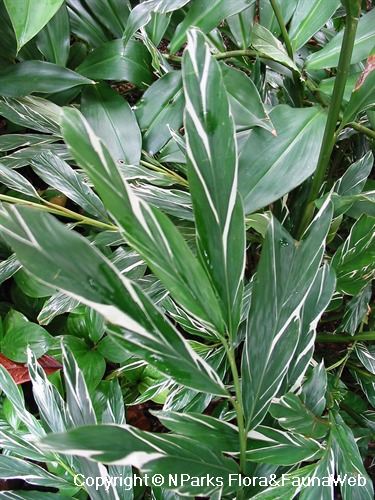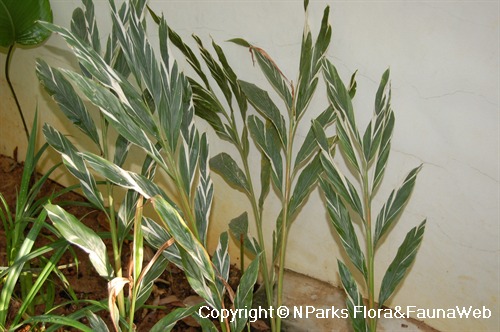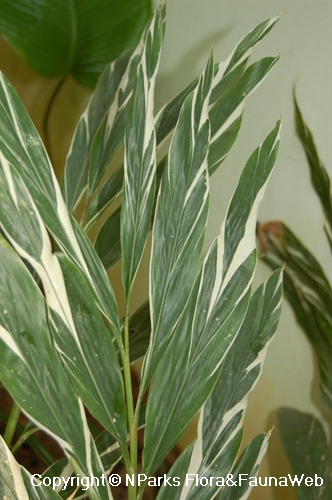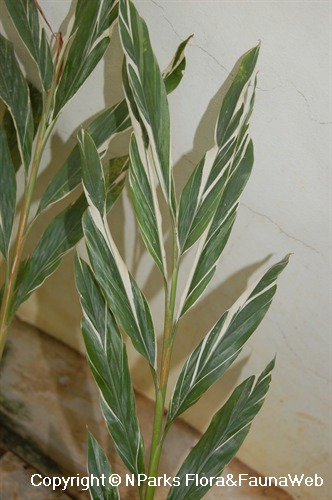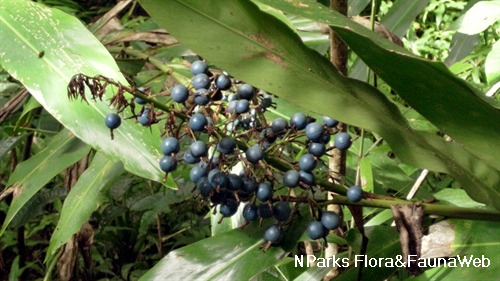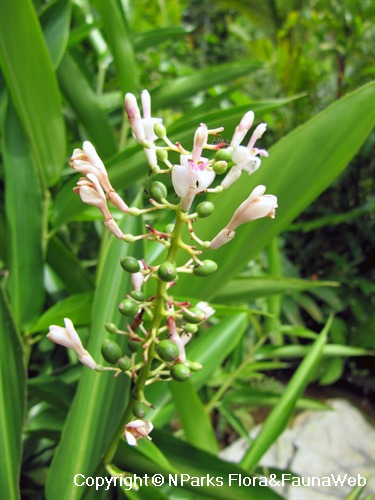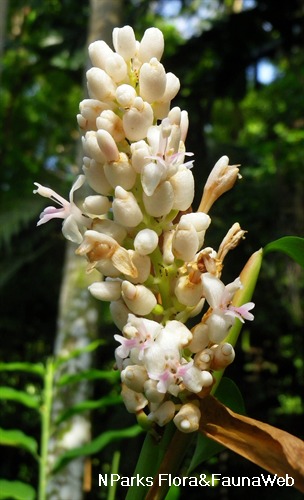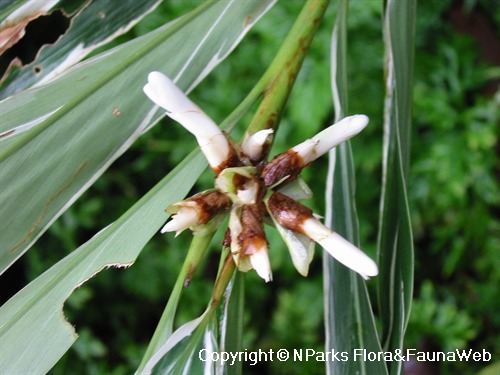
Back
Alpinia vittata W.Bull
| Family Name: | Zingiberaceae |
| Synonyms: | Alpinia sanderae Sander, Alpinia tricolor Sander, Guillainia vittata (W.Bull) Ridl. |
| Common Name: | Variegated Ginger, Striped Narrow-Leaf Ginger, Sander's Ginger |
Alpinia vittata or Variegated Ginger is an ornamental herb that reaches to 1.5 m in height. The lance-shaped foliage have white stripes of various width along the lateral veins. The tubular flowers are white, clustered together drooping downwards. Variegated Ginger is fast-growing which allow dense clumps to form easily, making an ideal species for border planting in partial to shaded sites.
Name
Classifications and Characteristics
| Plant Division | Angiosperms (Flowering Seed Plants) (Monocotyledon) |
|---|---|
| Plant Growth Form | Herbaceous Plant |
| Lifespan (in Singapore) | Perennial |
| Mode of Nutrition | Autotrophic |
| Maximum Height | 1.5 m |
| Maximum Plant Spread / Crown Width | 1 m |
Biogeography
| Native Distribution | Papua New Guinea, Polynesia, Solomon Islands |
|---|---|
| Native Habitat | Terrestrial (Primary Rainforest) |
| Preferred Climate Zone | Tropical |
| Local Conservation Status | Non-native |
Description and Ethnobotany
| Growth Form | It is a rhizomatous herb that occurs in dense clumps, up to 1.5 m in height. |
|---|---|
| Foliage | Its foliage are sessile, arranged alternately, lance-shaped measuring up to 20 cm long and 5 cm wide. The leaves have a waxy leaf margin, white stripes of varying width found along the lateral veins. |
| Flowers | Its flowers are borne in a cluster, drooping downwards. Each cluster measures between 18 - 25 cm long. The tubular flowers are pink to white coloured, with lobes bent slightly backwards. |
| Fruit | Its fruits are classified as capsules which are dry and spilt upon maturity. |
| Habitat | It occurs in wet tropical forests, along the margins or in forest openings. |
| Associated Flora | The flowers are pollinated by flies. The fruits are probably eaten by small mammals and birds. |
| Cultivation | It is fast-growing, forming dense clumps easily. It thrives fertile, slightly acidic soil that has good drainage. Although this species grows well in the shade, leaves will lose their variegation under deep shade. |
| Etymology | Etymology: The genus "Alpinia" was named after Prospero Alpino, a botanist from Italy (1553-1616). The specific epithet "vittata" is derived from the Latin word "vittatus" which means banded, referring to the striped leaves. |
Landscaping Features
| Landscaping | Ideal in semi-shady locations where the white-striped leaves and white flowers will help to brighten the area. It can be planted in mass or alone as a specimen planting. |
|---|---|
| Desirable Plant Features | Ornamental Foliage |
| Landscape Uses | Container Planting, General, Focal Plant |
Plant Care and Propagation
| Light Preference | Semi-Shade |
|---|---|
| Water Preference | Lots of Water, Moderate Water |
| Plant Growth Rate | Fast |
| Rootzone Tolerance | Disease / Pest Resistant, Well-Drained Soils, Acidic (low pH) Soils |
| Propagation Method | Division |
Foliar
| Foliage Retention | Evergreen |
|---|---|
| Mature Foliage Colour(s) | Green, White |
| Mature Foliage Texture(s) | Smooth |
| Foliar Type | Simple / Unifoliate |
| Foliar Arrangement Along Stem | Alternate |
| Foliar Attachment to Stem | Sessile |
| Foliar Shape(s) | Non-Palm Foliage (Lanceolate) |
| Foliar Venation | Pinnate / Net |
| Foliar Margin | Entire - Wavy / Undulate |
| Foliar Apex - Tip | Acute |
| Foliar Base | Acute |
| Typical Foliar Area | Mesophyll ( 45cm2 - 182.25 cm2 ) |
Non - Foliar and Storage
| Stem Type & Modification | Pseudostem |
|---|---|
| Root Type | Underground (Fibrous Root) |
| Specialised Storage Organ(s) | Underground (Rhizome) |
Floral (Angiosperm)
| Flower & Plant Sexuality | Bisexual Flowers, Bisexual Flowers |
| Flower Colour(s) | White |
|---|
| Flower Grouping | Cluster / Inflorescence |
| Flower Location | Terminal |
| Flower Symmetry | Radial |
| Individual Flower Shape | Tubular |
| Inflorescence Type | Spike |
| Flowering Habit | Polycarpic |
Fruit, Seed and Spore
| Fruit Classification | Simple Fruit |
|---|---|
| Fruit Type | Dehiscent Dry Fruit, Capsule |
References
| References | Chicago Botanic Garden (continuously updated). Chicago Botanic Garden. https://www.chicagobotanic.org/plantcollections/plantfinder/alpinia_vittata--marbled_ginger. Accessed 4 January 2022 Royal Botanic Gardens, Kew (continuously updated). Plants of the World Online | Kew Science. https://powo.science.kew.org/taxon/urn:lsid:ipni.org:names:17245530-1 . Accessed 16 December 2021. Royal Horticultural Society (continuously updated). RHS Gardening. https://www.rhs.org.uk/plants/26961/alpinia-vittata-(v)/details. Accessed 4 January 2022 |
|---|
Image Repository
Others
| Master ID | 353 |
|---|---|
| Species ID | 1649 |
| Flora Disclaimer | The information in this website has been compiled from reliable sources, such as reference works on medicinal plants. It is not a substitute for medical advice or treatment and NParks does not purport to provide any medical advice. Readers should always consult his/her physician before using or consuming a plant for medicinal purposes. |

